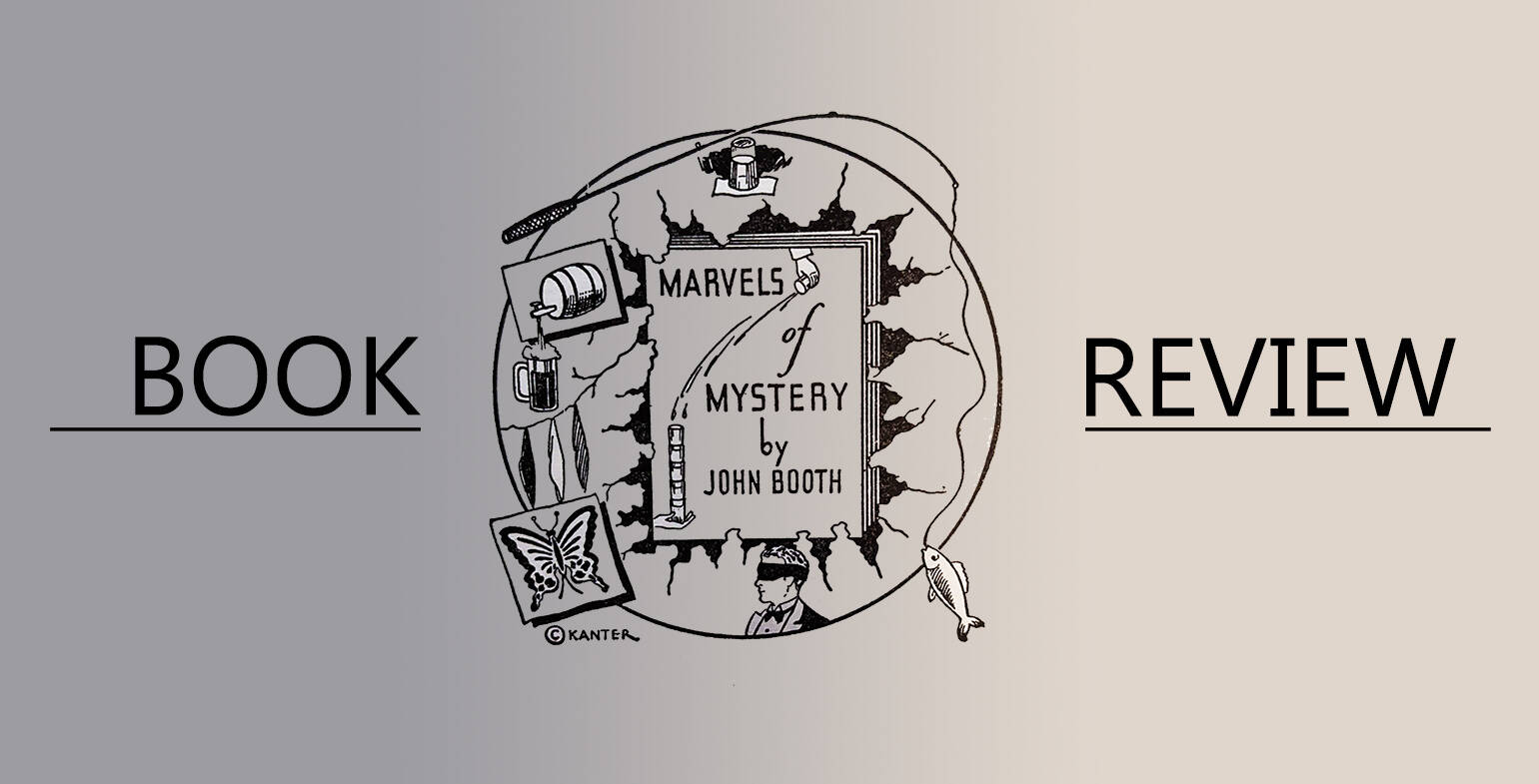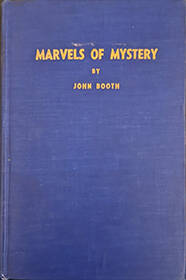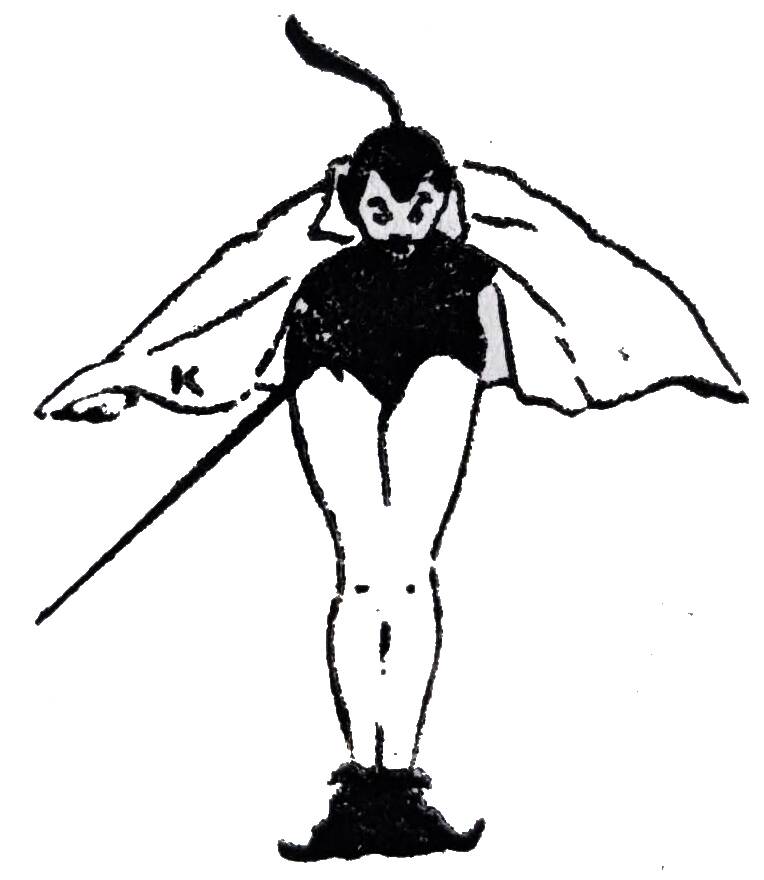

Marvels of Mystery by John Booth, a book published over 80 years ago and hailed to be one of the greatest magic books of the 20th century. Whether that's a true sentiment or not is to be decided by the reader and I've come up with my own opinions on the topic -- which you're about to read!
First though, a little about John Booth. He was a prolific author who had written hundreds of articles on magic for several magic magazines including Linking Ring, Sphinx, Genii, and Magicol among others. Chances are, you've come across material written by him before if you've read any of those periodicals, or one of his 16 published books! Interestingly enough, he was a working nightclub magician up through 1940 when he "left magic" to become a minister. Author's note here, but did he really "leave magic" if he was still publishing articles and books on the subject? Also, and I say this from experience, but can't you have a day job and still call yourself a magician?
The book itself was an accidental addition to my library but I'm glad it found its way in. I had ordered a very different book from eBay and this one arrived instead. The seller didn't accept returns so I was effectively "stuck" with a book I didn't order but hey, a book's a book! Given that the majority of it is not card magic I likely wouldn't have ordered this one myself, but it did give insight into so much of the world of magic that I have otherwise not been privy to.
I was surprised when I saw that the introduction was written by Mrs. Harry Houdini. Mainly, I didn't know she went by that name given Harry Houdini itself was a pseudonym and Weiss was still his legal name. Bess Houdini, or Weiss, stayed true to the love of magic and held on to not only the name but also continued working with other magicians such as Booth. Though, I'm not sure how great of a starting quote this is:
This unusual book of magic gives the complete details of the author's tricks, routines and original ideas as used in his acts.
Perhaps in the 1940's the verbiage came across as better. To me, "this unusual book" doesn't reach out to me as being all that great. Though she did go on to say "countless thousands of individuals on three continents may think they know Mr. Booth, Master Magician -- but do they?". Ah wait, that doesn't change too much, it still inspires an almost negative connotation to the mystery in our hands. Perhaps that was the intention?
Mickey Mouse Magic
Yes, Mickey Mouse Magic. No, not anything having to do with performing magic at Disney Land or magic that's specific for children. Chapter Five kicks off with a routine that's named Mickey Mouse Magic.
I want to set the stage really quick before I talk about this one. Timing is, as usual, everything. About a week, maybe two, before reading this book I was watching one of the latest episodes of Penn & Teller: Fool Us and one of the performers was Bobby Torkova. He presented a very beautiful performance of a classic in magic that he called "How to Make a Flag." Penn, during his judges-review piece, referenced it as a "silk dye routine" which it very much was, and he also dropped the name Al Baker. Now, I know Al Baker, but I don't know any silk magic beyond the use of a thumb tip -- and even that's a big guess. But yeah, such a beautiful routine that honestly fooled me completely because that's just not where I've studied. I highly recommend you watch the performance (https://www.youtube.com/watch?v=kgXV_P4Jpkg).
With the stage set, let's circle back to Mickey Mouse.
The first paragraph of the effect introduction has a very familiar line:
This "Mis-made Flag Trick" is unusually adaptable because there is a story, a sympathy arouser and a climax embodied within the effect.
Oh my... could it be the same trick that I had just witnessed? Spoiler alert -- it was! While Torkova's routine dyed silks to the design of an American flag, the routine in Marvels of Mystery creates one with the picture of Mickey Mouse on it. The colors of the silks and ending design are different, but the stages of the routines are identical. I read through this routine twice with fascination just to see how it could be done. It sounds pretty straightforward, but practice is definitely required.
I do really love the introduction patter:
"A very simple trick invented by two Chinese laundry-men, Al Foo Yu and Yu Foo Mee"
Half of the trick's explanation, like all the ones presented in the book, is "patter" and then a rundown of how to perform that actual routine itself. There's a decent amount of talking involved in the routine as it's described in the book. However, I point you back to Torkova's performance if the same routine where not a word was said. I, personally, have been trying to find ways to let the magic speak for itself and talk less (I'm... a talker) but I have trouble with seeing it work out. It's really great to have resources like this to see the same trick performed in two very different styles and both be just as magical as the other.
Unfortunately, I'm not a fan of how the trick is presented in the book. Don't get me wrong, the trick itself is great. The patter and performance is spot-on. But by the time I got to this chapter (the 5th, remember) I've already formed an opinion on Booth and the purpose of this book and honestly, it was reinforced here too.
The trick uses what is called a dye tube. Booth spends a lengthy paragraph talking about his custom made, of brass, dye tube and his "Mickey Mouses" silks were custom painted for him by W. C. Dornfeld. A lot of the tricks presented in this book require one or more apparatus to be purchased -- though his are, more often than not, custom made and are better than what you can buy. At least he gives the dimensions and material; if you're a professional magician who's going to perform this type of thing, I could see you investing in a custom made one for sure. Luckily, he ends the routine description by letting us know that Davenport and Co., in England, sells this Mickey Mouse Trick... sadly this was 80 years ago and it doesn't look like it's available by them anymore.
All of that said, now I want to get ahold of Al Baker's material to compare!
Chapter Three
The tricks in this chapter are either too well known or too easily procured and learned to require a description of their secrets. Yet they were carefully selected for frequent use in our work because of their dramatic value, their novelty and their really baffling effect. Recounted here is the patter and presentation for them which we used on the road with great success.
Have you ever been angry at a book before? Or the author of the book for something they put in it? I'm pretty sure I have in the past, but my most recent recollection is Chapter Three -- Patter Pets of Marvels of Mystery.
Why did Booth include this chapter? Just to have extra material printed in the book? To write down the tricks because they haven't been published before? I... have no idea, but I'm actually quite upset that he did.
Why though? Well please, let me explain!
There are three tricks outlined in Chapter Three:
- The Incredible Glass Penetration
- The Coin in the Bottle
- An Amazing Slate Prediction
As the quote above says, per Booth's opinion, these three tricks are either too well known or easy to purchase so he doesn't need to describe their secrets in this book. Again, so why include them?!
The first trick, The Incredible Glass Penetration, starts out with this effect description:
A sheet of glass within a picture frame is exhibited. Two playing cards are placed, one on each side, in the center of the glass where they are retained by spring clips. A glass rod is boldly pushed through the center of the cards and the glass. The two cards are immediately removed and seen to be punctured but the pane of glass is in the same solid state it enjoyed at the inception of the experiment.
The rest of the trick description is sample patter you could use when performing it, assuming you don't like the patter that comes with the trick when you purchase it. But that's it. There's no explanation as to how to perform it.
He does give credit to Messrs. Massey and DeMuth for creating and marketing the trick which helped me locate "The Penetration Frame" / "Glass Thru Glass", but that itself wasn't the easiest to track down. Perhaps Booth didn't have permission to print how the trick was done, or information about the gimmick itself? I still, really don't get why he included these tricks.
What's really fun though is that while I was reading this chapter and verbally announcing my annoyance, my older son asked me what's up and I explained that I'm reading a magic book that just said, "here's a trick that's so well known, we're not going to tell you how to do it" and then read the effect description. He said to me "oh I know how to do that!" Man, if ever did I do a doubletake. Of course, I asked him how he knows and he says "here, you want to see?"
Two minutes later, he takes two cards from the deck sitting next to me and slides them into this plastic frame that has a sheet of glass in the middle. He takes a pencil, jabs it through the center of the two cards and then removes them from the frame. Sure enough, the glass in the middle of the frame is still intact and my cards are... punctured. He learned the routine and got the gimmick from the FAO Schwarz Ultimate Magic Set that he got for Christmas (go grandparents!) and just happened to read that one a day or two earlier. Like I've said, timing is everything!
Like Booth, my son stuck to the code of magicians and didn't tell me how the trick was done though...
Aged Material but also not new at the time?
How many magicians today appear before the audience wearing a pair of white gloves? Gentleman's Gloves, to be exact. Honestly, if I could perform Gentleman's Gloves to Milady's Bouquet though, I probably would. The effect itself sounds awesome -- you come out with a dashing pair of gloves, suavely slip them off and toss them into the air where they change, feet above your head, into an attractive bouquet of flowers. Hot damn!
That is quality visual magic. But that's not what people tune in to see anymore. That, or magicians just don't perform it anymore, so folks don't see it. Maybe I should become a stage magician and bring back some silk flowers! According to Booth, I could score a set of twenty-five large size spring flowers in various colors, complete with silk outer leaves for greater durability, for about two dollars and fifty cents from my favorite dispenser of conjuring paraphernalia. Oh, and don't forget the white cotton gloves for fifty cents.
Undertakers wear gloves that will do very well.
The routine's a decent read because I've learned some very crafty ways to conceal things. My mind's been churning through ideas for cards with these approaches, though I haven't come up with anything really usable yet. Maybe one day!
There are several routines in this book that are like this though. They are great magic but have kind of fallen out over time. Maybe young magicians learn them to learn sleight of hand and some basics, but soon leave them to do other things. The ones in this book aren't exactly the easiest to perform though, and they tend to have a stronger magical appeal than some of the modern related ones (like making a wand turn into a bouquet of flowers).
However, there are also several routines in this book that I'm pretty sure have much better methods nowadays. Or at least I've seen performances with similar effects that are much stronger than what I see in the book. For example, Mind Controlling Matter sees a magician pour water into a cup (sorry, a goblet), and as the spectator then holds the cup, the water instantly turns into blue ink. Neat, sure. But to me, my first thought is "there was something in the cup and/or water that led to a delayed chemical reaction." And, well, that's exactly how it was done.
I'm sure folks even today would be shocked by it for sure, but stuff has advanced so much that I also think that most people would jump to a similar conclusion. The effect could be used in more subtle ways like multi-color changing liquid, covered by a cloth or something. I don't know, not my cup of tea. Oh, or, speaking of a drink, what about changing water into wine, or beer, or any other actual drinkable liquid? That "stronger" effect I was talking about - taking it one step further. Instead of using poisonous acids and turning a glass into, well, ink why not turn it into wine and let the spectator take a sip as a convincer!
Interestingly enough, when I came to the section about swallowing razor blades, I immediately thought of the Tarbell Series. I don't know how or why I remembered that trick being described in that specific book, but I did. I also knew that Tarbell was published at least a decade before Marvels of Mystery so I was wondering why Booth would print someone else's content without giving reference. And here's where that interesting part comes up -- turns out, the razor blade trick from Tarbell's book is actually from John Booth himself! Cross-referencing the two books side-by-side, the content in Tarbell's book (printed earlier) is much more informative than Booth's, and it also includes just about everything that Booth included too. Perhaps Booth simply wanted to publish it as his work too, opposed to it being contained in a collection of hundreds of other routines.
Though the razor blade trick was actually Booth's, it was published well before Marvels of Mystery came out, so we weren't really getting any new information there. Chapter Three also provided us with no good information. Many other tricks in this book were also referencing other tricks that already existed but the spin was Booth was using custom made gimmicks to perform them better. Let's be clear, the same thing happens today even in card magic. A trick that's been out for decades will be republished by someone who fully references the original source, but they are selling it as their own trick because of some tiny new nuance that they've added. Yay.
Takeaways
I'm not a stage magician or anywhere close to knowing much about the magic domains related to it. I've skimmed through one or two of the Tarbell books, but other than that, Marvels of Mystery is as close to it as I've gotten.
I would love to say that the contents of this book are outdated and there are better methods that exist today. However, the card routines in the book such as in Ne Plus Ultra Cards to Pocket and Three Card Revelation are actually still quite usable. While I do know of handlings that could be better, I honestly can't say I've ever seen or heard of a card revelation through a crystal before. I've ordered one to join the club though! If you're interested, I picked up this 2in crystal ball for just the purpose =]. Other routines that aren't card related, I really can't say one way or the other because I just don't know ... but they sound pretty outdated to me.
There are many great, though dated, reviews of this book and yet it does appear to have quality content. For me personally, I feel like it's a glimpse at both magic history and at the other vast areas of the magical world and I am glad I have read it. Even if you're a hobby-magician that focuses specifically on one type of magic, I recommend giving Marvels of Mystery a read. Except Chapter Three.

